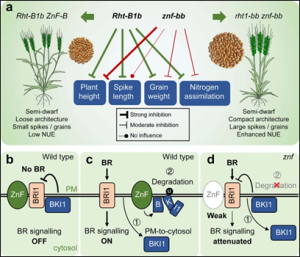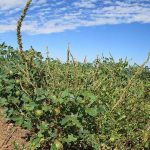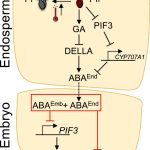Decreased brassinosteroid signaling enhances grain yield in semi-dwarf wheat
 The green revolution revolutionized crop productivity through the adoption of genetic advancements, particularly focusing on genes like Reduced height-1 (Rht-1) in wheat and semi-dwarf1 (sd1) in rice, which optimized plant architecture. However, these changes lowered the green revolution varieties’ (GRVs) ability to use nitrogen efficiently, requiring more chemical fertilizers to make up for the low nitrate uptake. Through QTL analysis for thousand-grain weight (TGW) in a segregating wheat population of Heng597 (Heng) × Shi4185 (Shi), Song et al. identified a deleted fragment of about 500 kilobases termed the r-e-z deletion in the Heng population. This deletion resulted in the loss of three genes: Rht-B1b, EamA-B, and ZnF-B. The r-e-z haploblock deletion conferred advantageous agronomic traits to the Heng population, notably significantly improved nitrogen use efficiency. Furthermore, the NIL-Heng (Near-Isogenic Line carrying the Heng genetic background) exhibited a higher grain yield compared to NIL-Shi at varying planting densities, ranging from 10.6% to 13.8% with much higher resistance to lodging. Both Rht-B1b and ZnF-B were found to have effects on plant height and TGW, but in an antagonistic manner. The ZnF protein, characterized by a RING-finger domain in its carboxy terminus and seven transmembrane domains in its amino terminus, acts as a positive regulator of brassinosteroid (BR) signalling. ZnF degrades a crucial BR signalling inhibitor, BRI1 KINASE INHIBITOR 1 (BKI1), at the plasma membrane. Consequently, genotypes with the r-e-z deletion exhibit semi-dwarf height due to decreased BR signalling controlled by ZnF, as well as increased TGW due to the absence of the Rht-B1 gene. This study provides a new strategy to improve the GRVs by exploring ZnF as a new source for semi-dwarfisms. (Summary by Mahesh Kumar Panda @maheshkumarMnP) Nature 10.1038/s41586-023-06023-6
The green revolution revolutionized crop productivity through the adoption of genetic advancements, particularly focusing on genes like Reduced height-1 (Rht-1) in wheat and semi-dwarf1 (sd1) in rice, which optimized plant architecture. However, these changes lowered the green revolution varieties’ (GRVs) ability to use nitrogen efficiently, requiring more chemical fertilizers to make up for the low nitrate uptake. Through QTL analysis for thousand-grain weight (TGW) in a segregating wheat population of Heng597 (Heng) × Shi4185 (Shi), Song et al. identified a deleted fragment of about 500 kilobases termed the r-e-z deletion in the Heng population. This deletion resulted in the loss of three genes: Rht-B1b, EamA-B, and ZnF-B. The r-e-z haploblock deletion conferred advantageous agronomic traits to the Heng population, notably significantly improved nitrogen use efficiency. Furthermore, the NIL-Heng (Near-Isogenic Line carrying the Heng genetic background) exhibited a higher grain yield compared to NIL-Shi at varying planting densities, ranging from 10.6% to 13.8% with much higher resistance to lodging. Both Rht-B1b and ZnF-B were found to have effects on plant height and TGW, but in an antagonistic manner. The ZnF protein, characterized by a RING-finger domain in its carboxy terminus and seven transmembrane domains in its amino terminus, acts as a positive regulator of brassinosteroid (BR) signalling. ZnF degrades a crucial BR signalling inhibitor, BRI1 KINASE INHIBITOR 1 (BKI1), at the plasma membrane. Consequently, genotypes with the r-e-z deletion exhibit semi-dwarf height due to decreased BR signalling controlled by ZnF, as well as increased TGW due to the absence of the Rht-B1 gene. This study provides a new strategy to improve the GRVs by exploring ZnF as a new source for semi-dwarfisms. (Summary by Mahesh Kumar Panda @maheshkumarMnP) Nature 10.1038/s41586-023-06023-6



